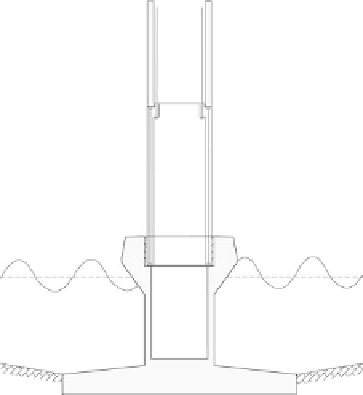Environmental Engineering Reference
In-Depth Information
Fig. 5.15 Compact foundation and tower made from prestressed precast concrete elements
5.4.1.2 Sequence of operations on site
1. Installation of foundation with heavy-lift crane vessel
2. Erection of first tower segment, internal prestressing, grouted joint
3. Erection of second tower segment on mortar bed joint, external prestressing
4. Erection of further tower segments with external prestressing
5.4.2 Design, construction, transport and erection
of concrete substructures
High-strength lightweight concretes are frequently used for concrete substructures
because these represent a weight-saving of approx. 20% over normal-weight concretes.
Owing to their very dense microstructure, high-strength lightweight concretes exhibit
excellent durability and are therefore particularly suitable for offshore applications. In
the past, high-strength lightweight concretes have been successfully used worldwide
for oil and gas platforms.
As a rule, the primary loadbearing elements of concrete support structures for wind
turbines are prestressed in order to improve the serviceability (to limit cracks,
deformations, etc.). The actions due to repeated loads (fatigue) are often especially
important when designing the cross-sections (see Section 4.9).
The costs of the materials for and construction of concrete support structures for offshore
wind turbines are comparatively low. Moreover, exploiting series production and pre-
fabrication options can make a considerable contribution to optimising the costs. Contrast-
ingwith this, however, are themuchhigher dead loads of such substructures. They frequently
weighbetweenapprox. 3000and5000 t andare therefore far heavier than steel substructures.
The high self-weight places considerable demands on the fabrication yards and
especially the offshore logistics (transport and erection). There are currently only a


